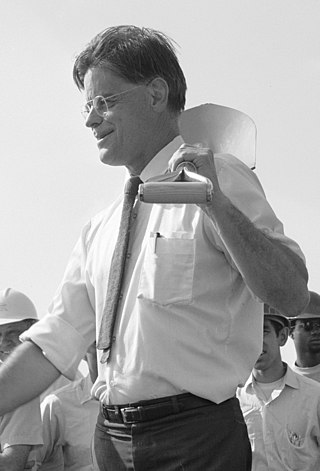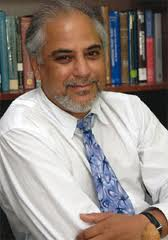Related Research Articles

Leon Max Lederman was an American experimental physicist who received the Nobel Prize in Physics in 1988, along with Melvin Schwartz and Jack Steinberger, for research on neutrinos. He also received the Wolf Prize in Physics in 1982, along with Martin Lewis Perl, for research on quarks and leptons. Lederman was director emeritus of Fermi National Accelerator Laboratory (Fermilab) in Batavia, Illinois. He founded the Illinois Mathematics and Science Academy, in Aurora, Illinois in 1986, where he was Resident Scholar Emeritus from 2012 until his death in 2018.

DESY, short for Deutsches Elektronen-Synchrotron, is a national research centre for fundamental science located in Hamburg and Zeuthen near Berlin in Germany. It operates particle accelerators used to investigate the structure, dynamics and function of matter, and conducts a broad spectrum of interdisciplinary scientific research in four main areas: particle and high energy physics; photon science; astroparticle physics; and the development, construction and operation of particle accelerators. Its name refers to its first project, an electron synchrotron. DESY is publicly financed by the Federal Republic of Germany and the Federal States of Hamburg and Brandenburg and is a member of the Helmholtz Association of German Research Centres.

Burton Richter was an American physicist. He led the Stanford Linear Accelerator Center (SLAC) team which co-discovered the J/ψ meson in 1974, alongside the Brookhaven National Laboratory (BNL) team led by Samuel Ting for which they won Nobel Prize for Physics in 1976. This discovery was part of the November Revolution of particle physics. He was the SLAC director from 1984 to 1999.

The Superconducting Super Collider (SSC) was a particle accelerator complex under construction in the vicinity of Waxahachie, Texas, United States.

Robert Rathbun Wilson was an American physicist known for his work on the Manhattan Project during World War II, as a sculptor, and as an architect of the Fermi National Accelerator Laboratory (Fermilab), where he was the first director from 1967 to 1978.

A synchrotron is a particular type of cyclic particle accelerator, descended from the cyclotron, in which the accelerating particle beam travels around a fixed closed-loop path. The magnetic field which bends the particle beam into its closed path increases with time during the accelerating process, being synchronized to the increasing kinetic energy of the particles. The synchrotron is one of the first accelerator concepts to enable the construction of large-scale facilities, since bending, beam focusing and acceleration can be separated into different components. The most powerful modern particle accelerators use versions of the synchrotron design. The largest synchrotron-type accelerator, also the largest particle accelerator in the world, is the 27-kilometre-circumference (17 mi) Large Hadron Collider (LHC) near Geneva, Switzerland, built in 2008 by the European Organization for Nuclear Research (CERN). It can accelerate beams of protons to an energy of 6.5 tera electronvolts (TeV or 1012 eV).

Wolfgang Kurt Hermann "Pief" Panofsky, was a German-American physicist who won many awards including the National Medal of Science.

The Cornell Laboratory for Accelerator-based ScienceS and Education (CLASSE) is a particle accelerator facility located in Wilson Laboratory on the Cornell University campus in Ithaca, NY. CLASSE was formed by merging the Cornell High-Energy Synchrotron Source (CHESS) and the Laboratory for Elementary-Particle Physics (LEPP) in July 2006. Nigel Lockyer is the Director of CLASSE in Spring of 2023.

Roy F. Schwitters was an American physicist who was professor of physics at the University of Texas at Austin. He was formerly a professor of physics at Harvard and Stanford, as well as director of the Superconducting Super Collider.
Kurt Gottfried was an Austrian-born American physicist who was professor emeritus of physics at Cornell University. He was known for his work in the areas of quantum mechanics and particle physics and was also a co-founder with Henry Way Kendall of the Union of Concerned Scientists. He wrote extensively in the areas of physics and arms control.

Helen Thom Edwards was an American physicist. She was the lead scientist for the design and construction of the Tevatron at the Fermi National Accelerator Laboratory.

Swapan Chattopadhyay CorrFRSE is an Indian American physicist. Chattopadhyay completed his PhD from the University of California (Berkeley) in 1982.

The Cornell Electron Storage Ring is a particle accelerator operated by Cornell University and located 40 feet beneath a football field on their Ithaca campus. The accelerator has contributed to fundamental research in high energy physics and accelerator physics, as well as solid state physics, biology, art history and other fields through its use as a synchrotron light source. For many years, CESR held the world luminosity record for electron-positron collisions.

A particle accelerator is a machine that uses electromagnetic fields to propel charged particles to very high speeds and energies, and to contain them in well-defined beams.
An energy recovery linac (ERL) provides a beam of electrons used to produce x-rays by synchrotron radiation. First proposed in 1965 the idea gained interest since the early 2000s.
Robert Harry Socolow is an American theoretical physicist and professor emeritus of Mechanical and Aerospace Engineering at Princeton University.

Asoke Nath Mitra was an Indian theoretical physicist. He was a lifetime professor emeritus at Delhi University. He is known for his work in nuclear physics, particle physics and quantum field theory and in particular, for his fundamental contributions in obtaining the exact solution of the nucleon 3- body problem with separable potentials which led to the few nucleon studies, quark-recoil effect, development of an integrated dynamics of 2- and 3- body systems from nucleons to quarks as well as for the development of quark dynamics and relativistic quark models for hadrons in the Bethe-Salpeter framework. He was awarded the Shanti Swarup Bhatnagar Prize in 1969.
The Leo Szilard Lectureship Award is given annually by the American Physical Society (APS) for "outstanding accomplishments by physicists in promoting the use of physics for the benefit of society". It is given internationally in commemoration of physicist Leo Szilard.
"In the year's of Szilard's life and activity it became clearer than ever before how great the responsibility of scientists is to the society. And, to a large extent, it is due to Szilard that this awareness began to spread in the scientific community." - Andrei Sakharov
Alexander Wu Chao is a Taiwanese-American physicist, specializing in accelerator physics.
References
- ↑ "Cornell's laboratory is at the crossroads". CERN. Retrieved 30 October 2022.
- ↑ "M. Tigner". AIP. Retrieved 30 October 2022.
- ↑ HEPAP's Subpanel on Vision for the Future of High-Energy Physics (May 1994). "The Superconducting Super Collider Project. A Summary". Archived from the original on 8 July 2008.
- ↑ "Industry eyes the next big collider". 1 July 2007. Retrieved 30 October 2022.
- ↑ "Maury Tigner" . Retrieved 30 October 2022.
- ↑ "Member Directory". National Academy of Sciences. Retrieved 30 October 2022.
- ↑ "2000 Robert R. Wilson Prize for Achievement in the Physics of Particle Accelerators Recipient: Maury Tigner". APS. Retrieved 30 October 2022.
For notable contributions to the accelerator field as an inventor, designer, builder, and leader, including early pioneering developments in superconducting radio-frequency systems, inspiration and intellectual leadership for the construction of CESR, and leadership of the SSC Central Design Group
- ↑ "2005 Leo Szilard Lectureship Award Recipient". APS. Retrieved 30 October 2022.